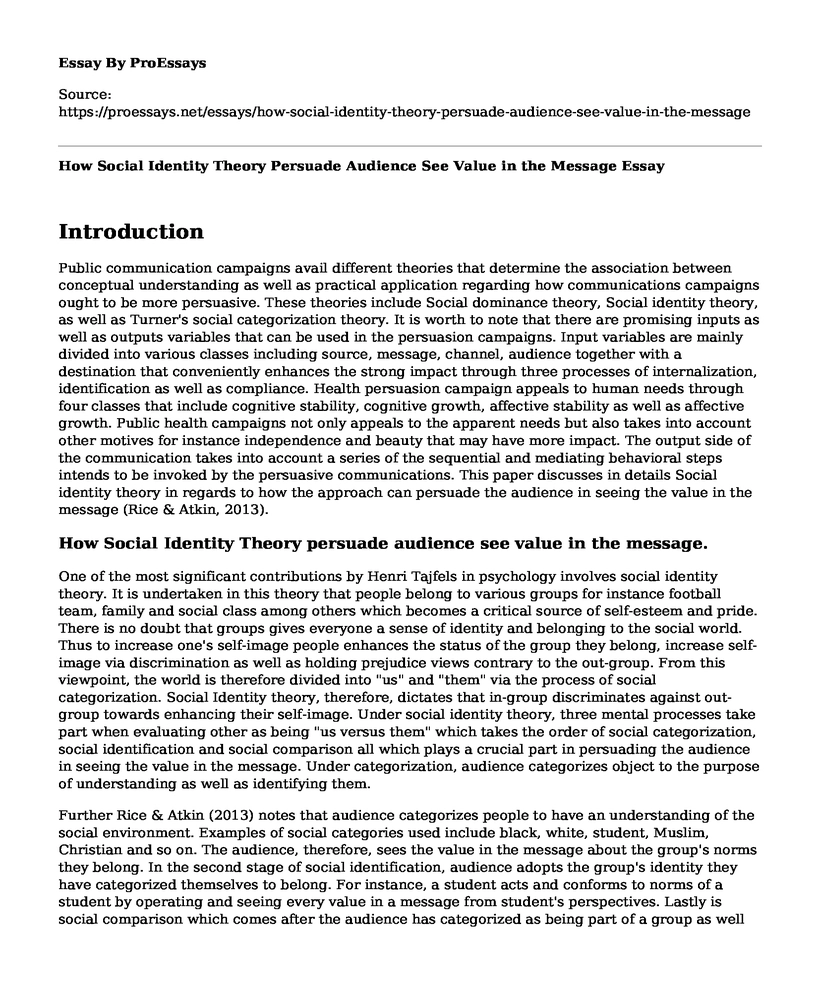Introduction
Public communication campaigns avail different theories that determine the association between conceptual understanding as well as practical application regarding how communications campaigns ought to be more persuasive. These theories include Social dominance theory, Social identity theory, as well as Turner's social categorization theory. It is worth to note that there are promising inputs as well as outputs variables that can be used in the persuasion campaigns. Input variables are mainly divided into various classes including source, message, channel, audience together with a destination that conveniently enhances the strong impact through three processes of internalization, identification as well as compliance. Health persuasion campaign appeals to human needs through four classes that include cognitive stability, cognitive growth, affective stability as well as affective growth. Public health campaigns not only appeals to the apparent needs but also takes into account other motives for instance independence and beauty that may have more impact. The output side of the communication takes into account a series of the sequential and mediating behavioral steps intends to be invoked by the persuasive communications. This paper discusses in details Social identity theory in regards to how the approach can persuade the audience in seeing the value in the message (Rice & Atkin, 2013).
How Social Identity Theory persuade audience see value in the message.
One of the most significant contributions by Henri Tajfels in psychology involves social identity theory. It is undertaken in this theory that people belong to various groups for instance football team, family and social class among others which becomes a critical source of self-esteem and pride. There is no doubt that groups gives everyone a sense of identity and belonging to the social world. Thus to increase one's self-image people enhances the status of the group they belong, increase self-image via discrimination as well as holding prejudice views contrary to the out-group. From this viewpoint, the world is therefore divided into "us" and "them" via the process of social categorization. Social Identity theory, therefore, dictates that in-group discriminates against out-group towards enhancing their self-image. Under social identity theory, three mental processes take part when evaluating other as being "us versus them" which takes the order of social categorization, social identification and social comparison all which plays a crucial part in persuading the audience in seeing the value in the message. Under categorization, audience categorizes object to the purpose of understanding as well as identifying them.
Further Rice & Atkin (2013) notes that audience categorizes people to have an understanding of the social environment. Examples of social categories used include black, white, student, Muslim, Christian and so on. The audience, therefore, sees the value in the message about the group's norms they belong. In the second stage of social identification, audience adopts the group's identity they have categorized themselves to belong. For instance, a student acts and conforms to norms of a student by operating and seeing every value in a message from student's perspectives. Lastly is social comparison which comes after the audience has categorized as being part of a group as well as being identified with such group hence comparing it with other groups. If the self-esteem of the audience has to be maintained, then the needs of his/ her groups require a favorable comparison with other groups (Rice & Atkin, 2013).
Conclusion
In conclusion, it is critical for everyone to understand audience's prejudice from social identity theory viewpoint to avoid any unnecessary instances of rivals and competition when passing message besides making sure that the value in the message not taken the wrong way.
Reference
Rice, R. E., & Atkin, C. K. (2013). Public communication campaigns (4th ed.). Retrieved from https://us.sagepub.com/en-us/nam/public-communication-campaigns/book234975
Cite this page
How Social Identity Theory Persuade Audience See Value in the Message. (2022, Nov 09). Retrieved from https://proessays.net/essays/how-social-identity-theory-persuade-audience-see-value-in-the-message
If you are the original author of this essay and no longer wish to have it published on the ProEssays website, please click below to request its removal:
- Effects of CSR and Price in Determining Consumer Reaction
- Alternative Work Arrangements and Work-Family Balance Essay
- Lack of Diversity in the Boston Police Department Essay Example
- Essay Sample on Most Important Information in the Design of the Sales Incentive Plan
- Essay Sample on Traditional to Modern: The Transition of Chinese and Pakistani Weddings
- Essay Example on Walmart's Expansion: Benefits, Threats, and Challenges in Global Markets
- Paper on Moral Principles: Impact on Society and Individuals







